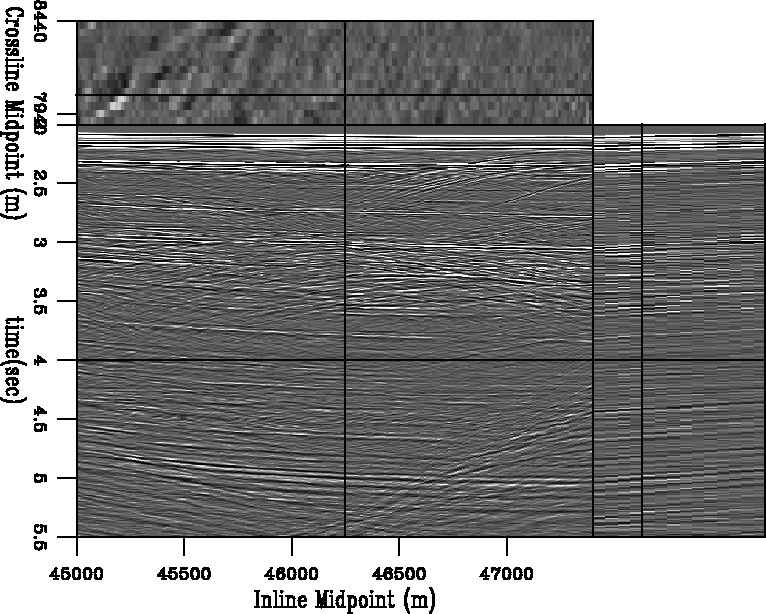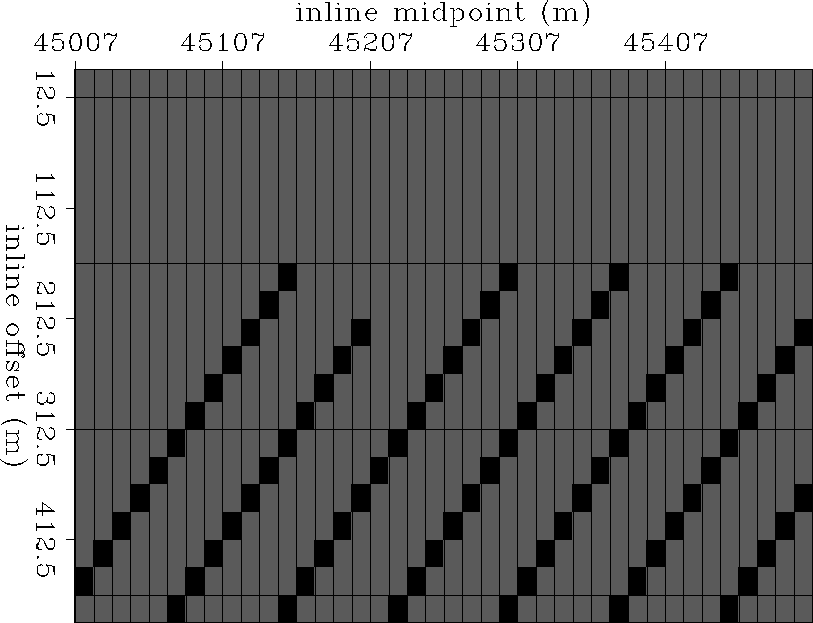CGG's 3-D data were acquired by a ship sailing east-to-west, in the strike
direction relative to the dominant geologic dip. The subset of the data that I
process in this paper contains fairly significant crossline dip (![]() )in most places. Figure 3 shows a stacked section of the
subset, which contains 192 midpoints inline and 14 midpoints crossline. The
stacked section includes contributions from two adjacent sail lines, the
geometries of which are illustrated in Figure 4.
)in most places. Figure 3 shows a stacked section of the
subset, which contains 192 midpoints inline and 14 midpoints crossline. The
stacked section includes contributions from two adjacent sail lines, the
geometries of which are illustrated in Figure 4.
 |
 |
The subset shown in Figure 3 is situated in a sedimentary minibasin, with strong reflections visible at a two-way traveltime of well over 5 seconds. Thanks to a strong velocity gradient and the sparse offset sampling, surface-related multiples are largely absent from the stacked section. Still, as we shall see, the multiples are fairly strong in the prestack data and inhibit prestack amplitude analysis. The section exhibits moderate reflector dip - an anticlinal structure in the inline direction and effectively constant crossline dip of several degrees.
The acquisition ship sailed quite fast, with a flip-flop source interval of 37.5 meters, and an interval of 75 meters between like sources. The fast ship speed leads to reduced resolution along the inline offset axis: for an 8100-meter cable with receiver group spacing of 25 meters, the nominal CMP fold is only 54, implying a nominal inline offset spacing of 150 meters. Figure 5 illustrates the sparse sampling of the inline offset axis. While the nominal inline offset bin size of 150 meters ensures that all bins will contain a live trace, such sparsity will greatly inhibit the estimation of reasonable stacking velocities and create ``checkerboard'' artifacts in the shallow portions of a stacked image.
|
sparse.gc3d
Figure 5 Illustration of sparsity of inline offset axis of CGG Green Canyon IV data. Grid represents nominal bin size of 150x12.5 meters. Black dots correspond to trace locations. |  |
Therefore, in my processing of this dataset, I use an offset bin spacing of 25 meters. While this fine sampling better honors the physics of the experiment, it leads to a fivefold increase in empty bins. Moreover, although I have cast LSJIMP primarily as a wavefield separation algorithm, recall that one major motivation of integrating multiples and primaries is to use the multiples as a constraint on the primaries in zones where we do not record data. Multiples sample reflectors more finely in reflection angle/offset than do primaries. Moreover, the regularization strategies discussed earlier provide the infrastructure to exploit the inherent multiplicity of signal within an image and between multiple and primary images. Although designed to separate signal and noise, these same strategies also prove adept at interpolating signal in missing traces.
Stacking velocities were computed by a conventional velocity scan, coupled with maximum amplitude autopicking and local weighted (stack power) mean smoothing. The residual weight, simply zero for missing traces, but one elsewhere, is particularly important to achieve a successful LSJIMP result.